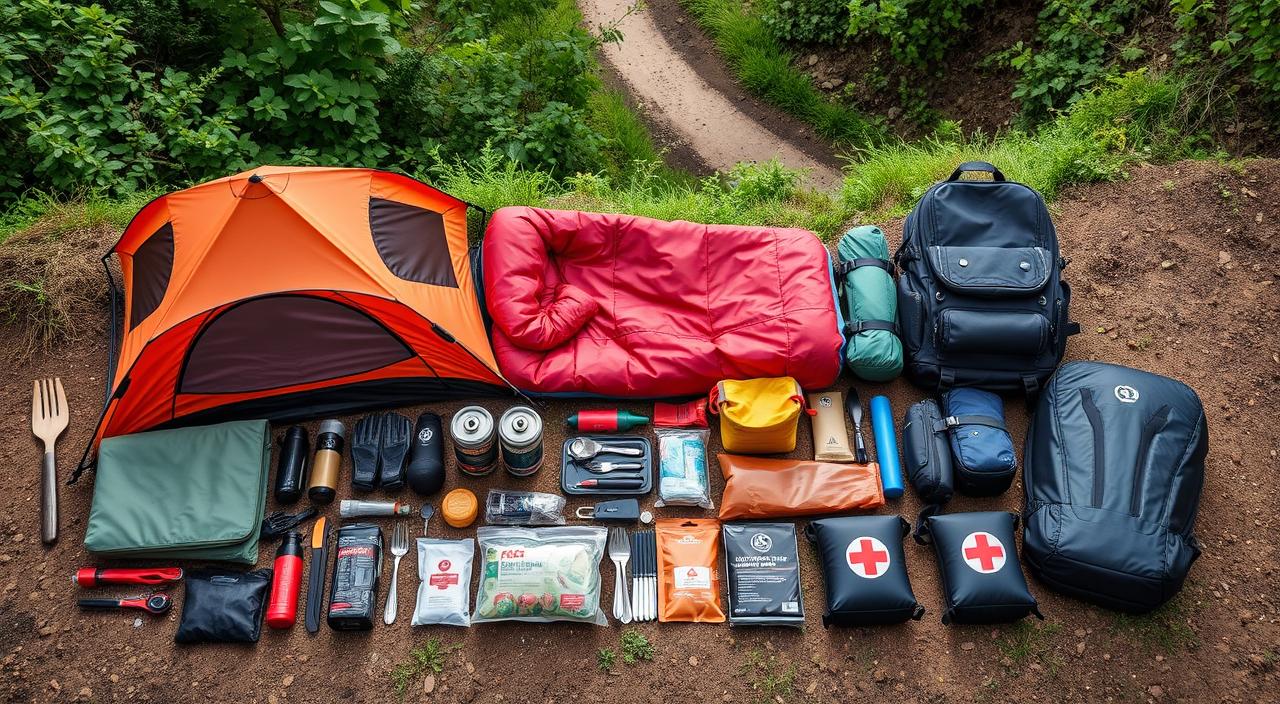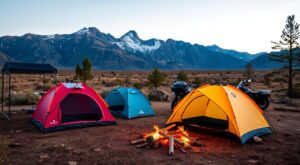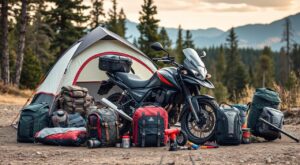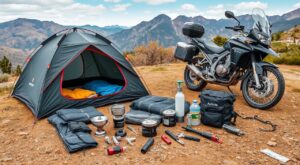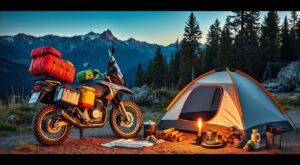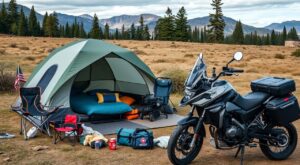I love the freedom and challenge of motorcycle camping. My gear is more than just stuff; it’s my key to adventure and peace. I focus on choosing items that are compact, efficient, and reliable.
A freestanding tent, like the MotoTent by Lone Rider, is a must-have. It’s easy to set up and flexible, loved by 97% of bikers. For cold nights, I use a sleeping bag rated for 15-degrees Fahrenheit, chosen by 84% of riders. An inflatable mattress completes my sleep setup, a favorite among 73% of motocampers.
For bikepacking, I pick lightweight and non-perishable food, favored by 68% of motorcyclists. A portable water filtration system is also key, used by 29% of those camping in the wild. And for off-the-grid power, a solar charger is a must, loved by 12% of riders. These motocamping essentials make any trip unforgettable.
Key Takeaways
- A free-standing tent is a must-have for ease of use and versatility during motorcycle trips.
- Opt for low-volume, warm sleeping bags to keep nights comfortable without the bulk.
- Inflatable mattresses are preferred over foam for compact packing and comfort.
- Select lightweight, non-perishable foods to make cooking on the road simpler and lighter.
- Personal hygiene can be maintained with small, packable shower bags, used by over half of motorcycle campers.
- Never underestimate the utility of a hatchet and a reliable water filtration system on motocamping trips.
- Staying powered up with a portable charger and solar panel is a necessity for staying connected.
Preparing for Your Journey: Motorcycle Camping Fundamentals
When planning for motorcycle camping preparation, focus on basic gear and strategies for lightweight travel. motocamping needs a balance between comfort and practicality. Make sure all essentials fit without overloading the motorcycle.
For a motorcycle camping trip, pick gear that does more than one job and fits your bike. Don’t overload your bike to avoid handling problems and save fuel. An experienced motocamping guide can offer great advice. This section shares tips on packing smart and making the most of your space.
| Statistic | Details |
|---|---|
| Motorcycle camping gear heavy-packers | 45% of riders pack items like oversized tents and luxury camp chairs, which might not be essential. |
| Ultralight motocampers | 25% forego basic amenities, including tents, opting for sleeping under the stars. |
| Shelters used | 60% use conventional tents, while 15% prefer bivy sacks or hammocks, highlighting diverse shelter preferences. |
| Essential camping utilities | 30% carry lightweight stoves like Jetboil, emphasizing the importance of compact, efficient cooking gear. |
To improve your packing motorcycle camping gear plan, choose versatile tools and compact gear. This ensures safety without cutting down on the adventure. Tools like a headlamp that doubles as a bike light save space and weight.
Finally, sort your gear by the trip’s environment and length. A long trip from Europe to Africa needs strong preparation and versatile gear. This ensures comfort and sustainability on the road.
Maintaining Your Motorcycle: On-the-Road Repairs and Tools
Having the right tools for repairs on a camping trip can save you a lot of trouble. When you’re far from professional help, knowing how to fix things yourself is key. It’s not just handy, it’s essential.
The Essentials of a Motorcycle Repair Kit
Think about what you might need to fix while camping. A flat repair kit and a multi-tool are must-haves. They can handle many repairs, like tightening screws or cutting wires. Also, keep spare bulbs and fuses handy for electrical problems, so you won’t be stuck in the dark or with a broken engine.
- Flat repair kit
- Multi-tool (including pliers, screwdrivers, tweezers, and knife)
- Spare bulbs and fuses
Choosing Durable and Reliable Tools
For reliable repairs on the road, pick tools that are tough and dependable. Look for tools that are light but strong. Spending on quality tools means fewer replacements and a ready toolkit for surprises.
| Tool Type | Features | Use Case |
|---|---|---|
| Multi-tool | Includes needle-nose pliers, wire cutters, screwdrivers, knife | General repairs and quick fixes |
| Socket driver and set | Compact, includes various bits (Philips, Torx, Allen) | Comprehensive bolt and screw handling |
| Bright headlamp | Hands-free, LED, long-lasting | Night-time repairs and setups |
With the right tools and some basic knowledge, fixing things on the road becomes easier. This prep boosts safety and keeps your camping trip smooth, free from bike troubles.
Shelter Solutions: Picking the Right Tent
Choosing the right tent is key when you’re going on a motorcycle camping trip. The right tent makes your camping trip more comfortable and practical. It’s important to pick a shelter that fits the needs of motorcycle travel. Look for a tent that’s light, packs small, and can handle different weather.
Lightweight and Durable Tents for Bike Packing
If you love motorcycle travel, you’ll want a tent that’s light and easy to pack. The perfect tent is under 3.5kg or 7.7lbs and doesn’t take up much space. Tents like the Snugpak Ionosphere or Big Agnes are great for bikers. They set up in just 10 minutes and are small when packed.
Weather Resistance and Seasonal Adaptability
It’s important to have a tent that can stand up to the weather. Look for weatherproof camping shelters that keep out rain and wind but also let in air. A tent with a removable fly cover is great for stargazing on clear nights. A vestibule is also useful for storing gear or cooking when it’s raining, making your tent more useful.
| Feature | Benefits |
|---|---|
| Weight <3.5kg / 7.7lbs | Prevents bike overload, maintaining optimal performance |
| Compact packing | Conserves valuable storage space on motorcycle |
| Freestanding structure | Suitable for a variety of terrains, easy setup |
| Weatherproofing | Keeps campers dry and comfortable in varied conditions |
| Vestibule space | Extra area for storage and activities protected from weather |
| Removable fly cover | Allows for ventilation and stargazing during warmer nights |
Choosing the right motorcycle camping tents lets you enjoy your adventure no matter the weather. Whether you’re in the mountains or the forest, your tent is your home away from home.
Sleep Systems: Ensuring Comfort and Warmth
Going on a motorcycle camping trip means you need to be well-prepared, especially for a good night’s sleep. A key part of this is having a motorcycle camping sleep system with compact sleeping bags and sleeping pads for motocamping. These items are crucial for staying warm and comfortable.
I always choose the Big Agnes Diamond Park sleeping bag. It has a special sleeve that keeps the sleeping pad in place, just like your bed at home. This feature is great because it stops the pad from moving around at night, which can be annoying.
For most motorcycle camping trips in the three-season period, a 20-degree rated sleeping bag is perfect. It’s warm enough but not too heavy, making it versatile for different climates. Plus, it doesn’t take up too much space, which is important for packing.
Another idea is to use a lightweight and compact cot. Sleeping off the ground can make a big difference. It keeps you away from cold and uneven surfaces, which helps you sleep better.
Here are some options and things to consider for a motorcycle camper’s sleep system:
| Item Type | Benefits | Example |
|---|---|---|
| Compact Sleeping Bag | Lightweight, warmth, quick drying in damp conditions. | Down and synthetic options depending on climate conditions. |
| Sleeping Pad | Insulation from ground, comfort enhancement. | Big Agnes or similar with integration sleeve for sleeping pads. |
| Lightweight Cot | Elevates from ground, protects from cold. | Compact designs that fit well with motorcycle space limitations. |
Adding things like an inflatable pillow and a headlamp with a red-light setting can also make your camping more comfortable. The red-light setting helps you see at night without ruining your night vision. This is useful for moving around the campsite or looking at the stars.
Keeping your gear organized is important. I use packing cubes to keep my sleeping gear tidy and easy to find. This way, I save space and make setting up at the campsite easier after a long ride.
When picking a motorcycle camping sleep system, think about how compact, comfortable, and suitable it is for the weather. With the right compact sleeping bags and sleeping pads for motocamping, you can enjoy peaceful nights under the stars.
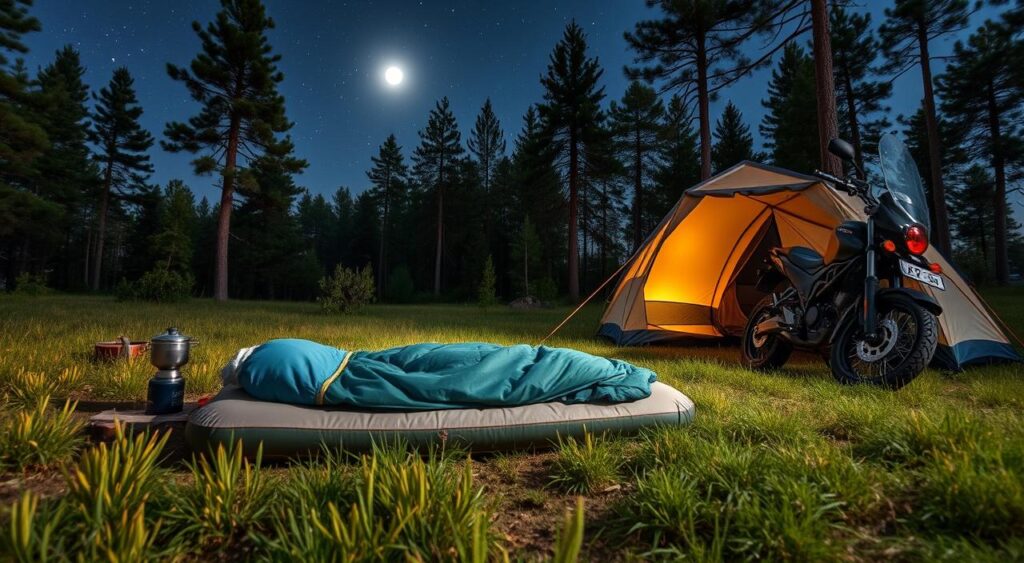
Hydration and Nutrition: Food and Water Essentials
When going on a motorcycle camping trip, proper camping meal planning and motorcycle camping hydration are key. They keep you energized and healthy. It’s important to stay hydrated because riding is hard work and heat from the asphalt can make dehydration worse. Also, using portable cookware for motocamping lets me cook meals anywhere.
To stay hydrated, I always bring a collapsible water bottle that holds 30oz of water and iodine tablets for cleaning the water. Dehydration can be serious, and our bodies are mostly water. So, drinking water, sports drinks, or coconut water is important to keep our electrolytes balanced. This is especially true when we’re out in the sun for a long time.
For camping, I look for motorcycle camping stoves and mess kits that are both light and strong. I use a portable stove made for motorcycle camping that has one burner. It’s great for making quick meals. Teflon frying pans are also good because they’re easy to clean, which is important when you’re camping.
I like to pack food that doesn’t spoil easily and is easy to make. Dehydrated meals are perfect because they just need hot water. Carrots, onions, and potatoes are also good because they don’t need to be kept cold and are full of nutrients. For protein, pre-packed fish like tuna is a great choice for the first night in the wild. It’s nutritious and easy to make.
Here’s a table with the key gear and food items I need for my trip:
| Item Category | Recommendations | Purposes |
|---|---|---|
| Hydration | Collapsible water bottle, Sports drinks | Hydration maintenance, Electrolyte replenishment |
| Cooking Gear | Mess kit, Portable stove, Teflon frying pan | Easy cooking and transportation, Non-sticky and easy to clean |
| Food | Dehydrated meals, Carrots, Onions, Potatoes, Tuna | Non-perishable, Easy preparation, Nutritional provision |
By focusing on motorcycle camping hydration and using portable cookware, I make sure my trips are fun, safe, and healthy. Planning my meals and snacks carefully is what makes the trip enjoyable and sustainable.
Essential Gear for Motorcycle Camping
When you’re into motorcycle camping, having the right motocamping essentials is key for safety and comfort. It’s all about knowing what to pack for a great experience. This guide covers the basics: Shelter, Something to Sleep in, Something to Eat, and Something to Drink. This way, every trip into the wild is memorable and safe.
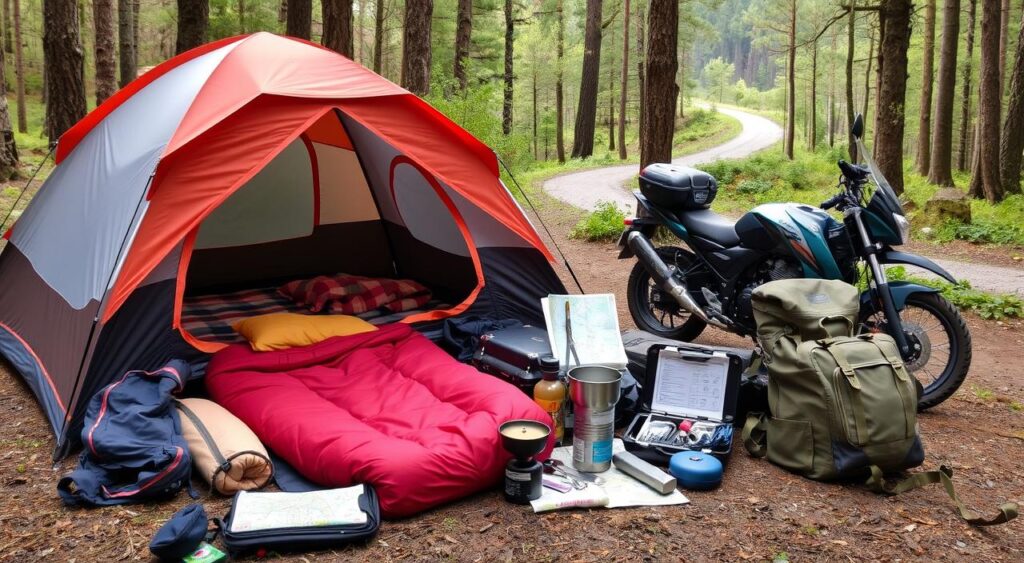
First, you need good shelter against the weather. You can choose from tents, hammocks, tarp shelters, or just a sleeping bag for the rugged type. Each option offers different levels of comfort, weight, and convenience. So, pick what fits your environment and what you like.
Next, getting enough sleep is crucial, especially with limited space on your bike. For cold nights, a Diamond Park sleeping bag from Big Agnes is perfect, designed for temperatures as low as 0 degrees Fahrenheit. For warmer trips, a wool blanket or a Snugpak Travelpak might be enough.
Food is vital, and your cooking gear should be easy to set up and save space. The UST Trekker and Jetboil Flash are great for quick meals or boiling water. And don’t forget about staying hydrated with options like Nalgene bottles, Sea to Summit Pack Tap, or Camelbaks.
It’s also important to purify your water. Boiling, using a Sawyer Squeeze filter, or a Katadyn gravity filter can keep your drinking water safe, especially in remote areas.
| Essential Category | Recommended Gear | Highlights |
|---|---|---|
| Shelter | Traditional Tent, Tarp, Hammock | Versatile options catering to all preferences and weather conditions |
| Bedding | Sleeping Bags (Big Agnes to Wool Blankets) | Temperature specific choices tailored for personal comfort |
| Cooking | Campfire, Isobutane Stoves | Compact and efficient cooking solutions |
| Hydration | Water bottles, Purification systems | Easily accessible hydration with safe purification practices |
Adding these camping gear for riders meets your basic needs and prepares you for emergencies. Don’t forget a first aid kit and a fire starting kit for safety. Keeping your bike locked up and having a first aid kit and a good water filter makes your trip both fun and safe.
This detailed look at motocamping essentials shows why the right gear is crucial for a safe and exciting motorcycle camping trip.
Packing Smart: Saddlebags and Storage Solutions
When you start motorcycle camping, picking the right saddlebags and storage is key for safety and ease. Packing for a motorcycle trip is not just about what you take. It’s also about how you pack it.
Hard Cases Vs. Soft Saddlebags: Making the Right Choice
Motorcycle camping fans often argue over hard cases versus soft saddlebags. Hard cases, like the Givi Outback Side Cases, cost between $490 and $892. They’re great for rough weather and tough roads. Soft saddlebags, such as the Mosko Moto Reckless 80L at $930, are versatile and light, helping with fuel efficiency and bike handling.
Think about your trip length, road types, and what you prefer in access and looks. For off-road trips with brush and debris, hard cases are best. For highway rides or short trips, soft saddlebags might be better.
Organizing Gear for Easy Access and Balance
Organizing your gear in your saddlebags or cases is crucial. It affects how you can reach items on the go and your bike’s balance. Tools like the SBVTools Pro Mechanic toolkit for $349 or the BikeMaster Tire And Tube Flat Repair Kit for $47.65 should be easy to get to. Less used items, like the NEMO Hornet Ultralight 2P Tent for $429.95, can go deeper in your luggage.
It’s important to balance the weight on your bike for stability. This is true for hard or soft saddlebags. Too much weight on one side can make handling hard, increasing accident risks, especially on rough roads.
Always test ride your loaded motorcycle to see how it handles. This ensures your packing choices improve your safety and fun on the trip.
Staying Connected: Communication Devices on the Road
When you go on motorcycle camping trips, keeping in touch is key for safety and planning. Rider communication systems like the Cardo PACKTALK use mesh technology to keep groups connected over long distances. Solo riders might prefer the Cardo FREECOM 1+, a simple Bluetooth helmet device for staying connected.
Having motorcycle helmet communicators means you can talk to other riders or call for help in an emergency. They make riding safer and more fun by letting you share updates and alerts easily.
Think about what you need in terms of function and cost. FRS radios are easy to use and don’t need a license. But if you want more power and features, GMRS radios are a good choice. They cost $35 for a 10-year license and offer more communication options, like the Radioddity GM-30 with Bluetooth and five watts of power.
The Rugged Radios motorcycle kit for GMRS communication is under $200. It’s made for rider communication systems, ensuring you stay connected on tough trails.
These systems help you coordinate with your group or listen to music. Tools like the BTECH GMRS-PRO offer text messaging and GPS, making your ride more connected.
Tapping into the advanced capabilities of motorcycle helmet communicators keeps everyone in the group connected, no matter the trail or weather.
Choosing the right motorcycle helmet communicators and Bluetooth helmet devices is key for motorcycle camping trips. They ensure safety, convenience, and fun on your adventure.
Navigating the Wilderness: Maps, GPS, and Orientation Tools
When I go motorcycle camping, knowing how to navigate the wilderness is key. I’ve learned that a mix of old-school and new-tech methods works best. Using GPS for camping and getting good at reading maps for motocamping is essential.
Understanding the Basics of Map Reading
Learning to read maps is the first step in navigating during motorcycle camping trips. It means understanding topographic lines, symbols, and scales to pick the best routes and spot important landmarks. Even with GPS, a paper map is crucial in places where signals or batteries might run out.
Modern GPS Technology for Route Planning
GPS has changed how we navigate motorcycle camping trips. Garmin Zumo makes rugged GPS units for motorcyclists going on long, off-road adventures. These devices give precise location tracking and help plan routes, avoiding closed paths and dangerous areas, and showing interesting places.
Before a trip, I think about packing smart and making sure my gear is easy to reach. Using light items and packing smart with bungee cords and compression bags keeps my stuff safe and doesn’t get in the way of riding.
| Feature | Benefits |
|---|---|
| Detailed Paper Maps | Do not rely on battery, provide elevation details, helpful in signal-less areas |
| Camping GPS Devices | Accurate location tracking, route customization, updates on road conditions |
| Smart Packing for Motorcycle Trips | Maximizes space, secures belongings, ensures smooth ride |
In conclusion, using both traditional map skills and modern GPS tech helps me navigate the outdoors confidently. This way, I can enjoy the thrill of motorcycle camping without getting lost.
Personal Care Items: Staying Healthy and Clean
In the world of motorcycle camping hygiene, keeping clean and healthy is key. This is true even with limited resources on the road. Whether you’re in a hammock or a tent, the right motocamping toiletries make a big difference. They offer comfort and keep you clean.
Personal Care Products for Camping: When packing for a motorcycle trip, I choose compact and leak-proof items. I pack biodegradable soap, toothpaste tabs, and shampoo bars. These save space and prevent spills. A microfiber towel and a quick-dry facecloth are also must-haves to stay dry and avoid infections.
A dedicated toiletry bag is key for organizing personal care products for camping. It should be small enough for tight spaces but strong enough for rough handling. This keeps everything in order and easy to find, which is important for cleaning up after a long ride or in the morning.
Here’s a table showing some motocamping toiletries essentials and why they’re better for motorcycle camping:
| Standard Item | Motocamping Alternative | Benefit |
|---|---|---|
| Bottle of Shampoo | Shampoo Bar | Reduces weight and avoids spillage |
| Liquid hand sanitizer | Alcohol-based hand sanitizer gel | Quick-drying and more convenient |
| Regular Towel | Microfiber Towel | Faster drying, takes less space |
| Standard Toothpaste | Toothpaste Tabs | No risk of leakage, precise dosage |
Knowing about motorcycle camping hygiene helps you choose the right toiletries. This depends on how often you shower or when you can shower. Common places to shower include state park campgrounds or truck stops. But when showers are scarce, hygiene wipes and hand sanitizers are key to staying clean.
Always dry your clothes well to avoid mildew. Synthetic or merino wool clothes dry fast, making them a good choice.
Whether you camp often or just seasonally, using these personal care products for camping keeps your trips fun and clean. Remember, taking care of yourself is a top priority on the road.
Conclusion
Our journey into motocamping has shown us the importance of a well-thought-out checklist. It’s all about finding the right balance between being compact and reliable. Each item should help you face the challenges of motorcycle camping.
Having a well-packed bike and the right gear is key. This includes a lightweight tent, a warm sleeping bag, and enough water for everyone. These items make sure you stay safe and comfortable.
My success came from packing my gear smartly. I put everything in panniers and a tail bag for even weight. This approach saved me money and space, letting me enjoy a $394 camping setup instead of spending $1,036.
This choice not only saved me $642 but also made my bike feel lighter. It was like carrying less than a 5-gallon water jug. This made my trip much easier.
To all motocampers out there, I say don’t forget about safety and communication. Always carry a first-aid kit and the right gear for the weather and terrain. Following these tips makes motocamping not just an adventure but a memorable part of your life.
